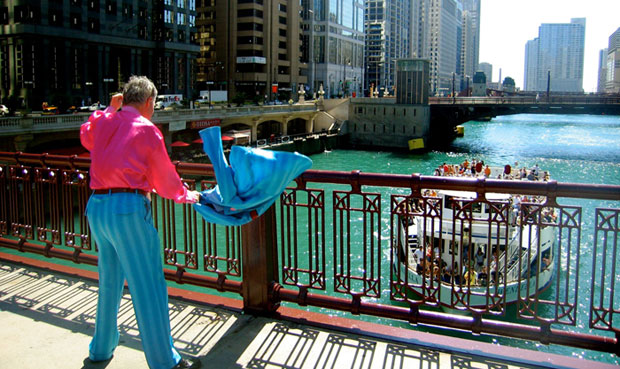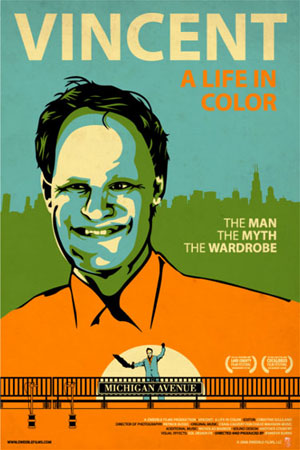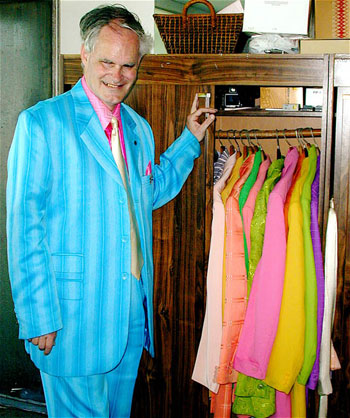
You might never have heard of Vincent P. Falk, but if you've been a visitor to Chicago you may well have seen him. He has performed for the patrons on every single tour boat cruising the Chicago River. And he is known to every viewer of the NBC/5 morning news, and the ABC/7 afternoon news. He's the smiling middle-aged man with a limitless variety of spectacular suits. He stands on the Michigan or State Street bridges, showing off his latest stupefying suit. He flashes the flamboyant lining, takes it off, spins it in great circles above his head, and then does his "spin move," pivoting first left, then right, while whirling the coat in the air. Then he puts it on again and waves to the tourists on the boat, by now passing under the bridge, always wearing a suit for the occasion: Shimmering black for Kwanzaa, red for Christmas, neon green for St. Patrick's Day so blinding Mayor Daley wouldn't have the nerve to wear it.
For ABC/7, he stands outside the big windows of the news studio, which open onto State Street. You can't miss him. For NBC/5, he's worked his way up to regular Friday morning appearances. The station's news studio overlooks Pioneer Court Plaza, and when the anchors go outside to chat with people, there's Vincent. He's agreed to appear exclusively on the Channel 5 early news, where I have never seen him, because his usual spin on Fridays is just before the 6 a.m. sign-on of the Today show.
He also does radio; WGN talker John Williams, interviewed in the film, does his show in a Tribune Tower studio with a window on Michigan Av. "I make it a point to not interact with people who try to get my attention," he says, "but Vincent..." It's possible Vincent's eyesight is so bad he can't even see Williams behind tinted glass in the daytime, but he knows the studio is there, just as he seems to know a lot of other things.
He's well-informed on the personnel of the TV news operations, for example, recently writing me: "For months, Channel 7 has been cutting me out of the crowd shots. But, recently, I've been getting in the shots on weekends. This is when Michael Wall is usually the director. But I'm still being cut out of the shots all the time on weekdays, when Jef Kos is usually the director." How many viewers with 20/20 vision know those names?

You might be forgiven for suspecting that Vincent is a few doughnuts short of a dozen. I know I did. Then I saw a remarkable new documentary by Jennifer Burns named "Vincent: A Life in Color," which unfolds into the mystery of a human personality. His life is one that Oliver Sachs, the poet of strange lives, might find fascinating. Considering that Vincent has been showing up for years and performing his "show" with flamboyant new suits, would it surprise you to learn that he is a college graduate? A computer programmer? A former deejay in gay North Side discos? Owns his own condo in Marina City? Buys his own suits? Legally blind?
All of these things are true. I can easily believe he buys his own suits. What I can hardly believe is that they are sold. We accompany him on a visit to his customary clothing store, which perhaps caters otherwise to members of the world's second oldest profession. Surely he's their best customer; I don't recall ever seeing the same suit twice in the film.
Jennifer Burns, who both produced and directed the film, says that like most Chicagoans, she'd seen Vincent and his colorful suits around for years. How could she not? Then one day she was looking out her office window, watching him performing for a tour boat, "and I was struck by the look of sheer joy I saw on his face. I thought to myself, whatever else you have to say about this guy, he has figured out what makes him happy and he does it, regardless of what anyone else thinks." She approached him, and he agreed to be the subject of a film--not surprising, since his pastime is drawing attention to himself. The subtext of the film is how differently life could have turned out for Vincent.
What Burns discovered was not quite the story we might have expected. Vincent, whose surname comes from one of his foster families, was an orphan abandoned by his mother, and raised at St. Joseph's Home for the Friendless. He was already blind in one eye, and glaucoma was dimming the sight in his other. After eight years he was placed in a foster home with Clarence and Mary Falk, who he considers his father and mother; he has had a star named after her. In the documentary, Sister Bernadette Eaton, who taught him as a boy, says at first she didn't realize he could read.
I e-mailed Vincent: "I'm missing something here. The nun says she was 'surprised' to learn you could read. So she didn't teach you. Did you teach yourself?" He responded quickly with a e-mail that was articulate and friendly. That was a surprise, because in the film he has some difficulty in expressing himself. His words don't flow smoothly, he repeats himself, gets tangled up, deflects questions with a joke. A co-worker in the doc says if you ask him something, he'll patiently respond, and then he's outta there. No small talk.
Vincent wrote: "I really don't remember who would have taught me to read. Maybe one of the other nuns. Maybe when I started going to school. I went to pre-school (they didn't have Kindergarten), 1st grade, and 2nd grade at St Joseph's. Then, I started 3rd grade my first school year after moving in with the Falks. And, I did attend all those grades at the proper time, with respect to my age (they didn't see a need to hold me back a year or so before starting me in 1st grade, or anything like that)."
I asked Burns what she thought. "I'm sorry this wasn't more clear in the film, Sister Anna Margaret (who declined to be interviewed) recognized that Vincent's problem wasn't intellectual but visual and taught him to read, along with the rest of the class, making sure he was always pushed up against the blackboard so he could see. It was the administration, who had previously written him off as incapable of learning, who were surprised to learn that Vincent could read."
In high school he was picked on; a classmate recalls students would sneak up behind him, tap him on the shoulder, and jump away before he could whirl and try to see them. He began to defend himself with humor, especially with puns, which are still an addiction. He didn't want to be considered blind any longer, Burns says, so he stopped using a cane. He was a member of the National Honor Society, the chess club, the debate team...and the diving team, luckily never diving into a pool without water. We meet his diving coach, who was as surprised as we are. It was in high school that he started wearing colorful suits, for reasons he does not explain. My theory: Being the class clown was better than being the class misfit.

Vincent reads with his left eye held less than an inch from a book or computer screen. He uses a monocular telescope for spotting approaching tour boats. His optometrist says he has severe tunnel vision; his good eye is a fraction of normal, and the visible image is like an iris shot surrounded by blur. He walks freely all over the Chicago Loop, often running a few steps or even skipping, so high are his spirits. The movie uses graphics to represent what he can see; it is terrifying to think of him crossing a street.
On his website, he does report one injury: "For the six week period from February 1, 2003 - March 8, 2003, there were no pictures posted to this site. This hiatus was caused by personal injury, due to being hit by a taxicab on January 29, 2003 (specifically, a Ford Crown Victoria). The accident occurred on Clark St. right by Quaker Tower."
Vincent, a bright student, was accepted at the Illinois Institute of Technology, studying aeronautical engineering. Yes. After two years he transferred to the University of Illinois, where he planned to study computer science in a program where admission standards are ruthless. At Urbana he became fascinated by audio equipment, not unusual among the visually impaired, "but my parents didn't like that, and hauled me back up to Chicago. They boxed up all my audio stuff and put it in the garage."
He got back into the audio field, and became a popular deejay, first for the go-go boys at Stage 618, and then at the gay disco Cheeks. He didn't exactly fit the image, his old boss recalls, and he held the albums an inch from his face, but he was a great spinner. It was during this time he concluded he was gay. For the past 20 years, he's been a computer programmer for Cook County, helping to track billions of dollars in tax revenue. "He's one of the most brilliant programmers I've ever met," his current boss says.
All of which is admirable, but how does it explain the suits? Having worn them since he was a teenager, he says he gave his first Chicago River bridge performance around 2000, adding the "spin move" about a year later. He knows the times when every tour boat passes his bridges, and the guides know his name and point him out as a landmark somewhere between the Wrigley Building and Marina City. To the guides on the Mercury boats, he is "Riverace" (rhymes with "Liberace"). The captain of one of the Wendella boats says you can set your watch by him. His bridges and the TV studios are within a short walk of his home.
There is a great deal of discussion in the documentary about Vincent's motivation. It explains nothing. Vincent himself will only say that he likes to entertain people, to cheer them up a little. One person in the doc speculates that Vincent has spent a lot of his life being stigmatized and isolated, and the suits are a way of breaking down barriers. I confess that the first time I saw him, I saw a man with unfocused squinting eyes and a weird suit, and leaped to conclusions. But by the time I saw this documentary, things had changed in my life. Anyone seeing me walk down the street would notice an unsteady gait, a bandage around my neck, and my mouth sometimes gaping open. If they didn't know me, they might assume I was the Village Idiot. You can easily imagine Vincent becoming an isolated agoraphobe, locked onto a computer screen. But he spends hours every day in the fresh air and sunshine, picking up that tan and getting lots of exercise.
That's why I respond to Vincent, and applaud him. If people take one look at me and don't approve of what they see, my position is: Fuck 'em if they can't take a joke. So here is a man who likes to wear pimp suits and wave them at tour boats. So why not? What are the people on the boats so busy doing that they don't have time for that? I suspect something like 99 percent of them are more entertained by Vincent than by the information that Mies van der Rohe designed the IBM Building, which stands across the street as an affront to the tinny new Trump Tower. As least they can smile and wave and tell the folks at home about that wacky guy they saw on the bridge.

"Vincent: A Life in Color" played the Wisconsin Film Festival in Madison in April, where Vincent brought along his orange and blue Illinois suit, to compete with Wisconsin's red, black and gold. Jennifer Burns says she plans a limited run in a Chicago indie house sometime this summer, as a help to a distribution deal. She deserves one. The film gathers an impressive array of people who have had roles in Vincent's life, including a lifelong friend who was another foster child with the Falks. It is beautifully photographed by Patrick Russo, who contrasts Vincent's life in color with the looming riverside architecture and its busy sidewalks. Vincent will never be mistaken for a man in the crowd.
On his web site, Vincent has photos of himself with virtually every one of the cows that were on display on Chicago sidewalks in 1999. Also with many of the subsequent sidewalk globes, bobbleheads, and couches. His suits always match the artworks. He takes his own self-portraits, using a camera on a tripod and an auto-timer. On the film's own website, you can find the column Neil Steinberg wrote for the Sun-Times about Vincent in 1975. It was Neil who sent me his DVD of this film.
Vincent writes me: "For your enjoyment, I have some Blagojevich humor (I'm sure you've heard of him). Recently, he wanted to go to Costa Rica to be on the TV reality show. This makes me think of someone who buys some very, very, very expensive cologne or perfume, and then splashes way too much of it on himself or herself. He or she would truly be a cost-a reekin!!!!??
Correcting the article, Vincent writes me: First, NBC5. I'm no longer there on Fri AM. The producers took away my 'spin spot' in Oct. 2007. You can still see me at Studio 5 once in a (great) while in the background during one of the evening newscasts (usually the 6PM news).
As for the bridges, my bridges of choice are Michigan Av and State St (not Wabash). But, I may temporarily move from Michigan Av to Columbus Dr. Apparently, the Bureau of Bridges is starting a repainting project on the lower level of Michigan Av Bridge. Today (Sunday), the north approach to the bridge was closed off due to the painting. I went to the other end of the bridge, and slipped around the barrier, so I could get on the bridge deck for my "fashion shows". (Don't worry, the Bureau of Bridges WILL get over it!!!!??!) But, if the painting work moves onto the bridge itself, I won't be able to do that, so it's over to Columbus.
In a related thing, you can thank the recession of the mid 1970's for the fact that I became a disco DJ. It's been said that the 1970's recession was the 2nd worst in the last 50 years, or so. Second only to the current recession. It was my inability to get a programming job in the period of 1974-1976 that caused me to wind up in the DJ booth.
Neil Steinberg wrote his article back in 2005, not last year as you said. It was written shortly before Jennifer started shooting her film. About a year earlier, an article was written in the Tribune. That's the one that was "regionalized" (it was seen only by people within the city, itself). They, also, took a photo of me in a bright, shiny, peach colored suit, and printed it in black and white (the nerve of them)!! There was an article about me last year, but that was the "good" Tribune article, written by Colleen Mastony.
And, for your benefit and/or enjoyment, did you know that basketball is the perfect game for a gay accountant to play?? If he launches the ball on a perfect trajectory, where it goes through the hoop, and touches nothing but fabric, the ball does tend to go "swish". He will achieve his "net" result."
Vincent also writes me: "Here is something else for you to enjoy." At the Wisconsin Film Festival, Jennifer and I were in a radio interview at a remote broadcast site run by WORT, a public radio FM station in Madison, WI. You'll get some good insights into Jennifer's film, and you'll feast your ear drums on some of my 'nuggets of humor.'
"I went to school at the UI in 'Cham-bana,' and Jennifer went to UW in Madison. So, at the end of the interview, I grabbed a chance to do something nice and "rude and nasty". Listen for it -- you'll enjoy it!!
"Note: The audio level is very low in this video. The camera was about 10 feet behind the place Jennifer was sitting. And they did not use the radio station's audio. The audio was picked up by the camera's own mic. You'll need to use a computer that is hooked up to either amplified speakers, or a stereo system. And, you'll have to crank that sucker up very loud."